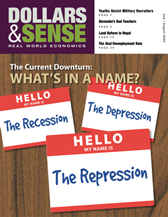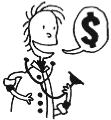This article is from the July/August 2009 issue of Dollars & Sense: Real World Economics available at http://www.dollarsandsense.org

This article is from the July/August 2009 issue of Dollars & Sense magazine.
Subscribe Now
at a 30% discount.

Dear Dr. Dollar:
What is the difference between a Ponzi scheme and the way the banks and other investors operated during the housing bubble?
—Leela Choiniere, Austin, Texas
As badly as our banking system operated in recent years, the housing bubble was not a Ponzi scheme. In some respects, however, it was even worse than a Ponzi scheme!
A Ponzi scheme is based on fraud. The operators of the scheme deceive the participants, telling them that their money is being used to make real or financial investments that have a high return. In fact, no such investments are made, and the operators of the scheme are simply paying high returns to the early participants with the funds put in by the later participants. A Ponzi scheme has to grow—and grow rapidly—in order to stay viable. When its growth slows, the early participants can no longer be paid the returns they expect. At this point, the operators disappear with what’s left of the participants’ funds—unless the authorities step in and arrest them, which is what happened with Charles Ponzi in 1920 and Bernard Madoff this year.
Fraud certainly was very important in the housing bubble of recent years. But the housing bubble—like bubbles generally—did not depend on fraud, and most of its development was there for everyone to see. With the principal problems out in the open and with the authorities not only ignoring those problems but contributing to their development, one might say that the situation with the housing bubble was worse than a Ponzi scheme. And Madoff bilked his marks out of only $50 billion, while trillions were lost in the housing bubble.
Bubbles involve actual investments in real or financial assets—housing in the years since 2000, high-tech stocks in the 1990s, and Dutch tulips in the 17th century. People invest believing that the price of the assets will continue to rise; as long as people keep investing, the price does rise. While some early speculators can make out very well, this speculation will not last indefinitely. Once prices start to fall, panic sets in and the later investors lose.
A bubble is similar to a Ponzi scheme: early participants can do well while later ones incur losses; it is based on false expectations; and it ultimately falls apart. But there need be no fraudulent operator at the center of a bubble. Also, while a Ponzi scheme depends on people giving their money to someone else to invest (e.g., Madoff), people made their own housing investments—though mortgage companies and banks made large fees for handling these investments.
Often, government plays a role in bubbles. The housing bubble was in part generated by the Federal Reserve maintaining low interest rates. Easy money meant readily obtainable loans and, at least in the short run, low monthly payments. Also, Fed Chairman Alan Greenspan denied the housing bubble’s existence—not fraud exactly, but deception that kept the bubble going. (Greenspan, whose view was ideologically driven, got support in his bubble denial from the academic work of the man who was to be his successor, Ben Bernanke.)
In addition, government regulatory agencies turned a blind eye to the highly risky practices of financial firms, practices that both encouraged the development of the bubble and made the impact all the worse when it burst. Moreover, the private rating agencies (e.g., Moody’s and Standard and Poor’s) were complicit. Dependent on the financial institutions for their fees, they gave excessively good ratings to these risky investments. Perhaps not fraud in the legal sense, but certainly misleading.
During the 1990s, the government made tax law changes that contributed to the emergence of the housing bubble. With the Taxpayer Relief Act of 1997, a couple could gain up to $500,000 selling their home without any capital gains tax liability (half that for a single person). Previously, capital gains taxes could be avoided only if the proceeds were used to buy another home or if the seller was over 55 (and a couple could then avoid taxes only on the first $250,000). So buying and then selling houses became a more profitable operation.
And, yes, substantial fraud was involved. For example, mortgage companies and banks used deceit to get people to take on mortgages when there was no possibility that the borrowers would be able to meet the payments. Not only was this fraud, but this fraud depended on government authorities ignoring their regulatory responsibilities.
So, no, a bubble and a Ponzi scheme are not the same. But they have elements in common. Usually, however, the losers in a Ponzi scheme are simply the direct investors, the schemer’s marks. A bubble like the housing bubble can wreak havoc on all of us.
Did you find this article useful? Please consider supporting our work by donating or subscribing.

